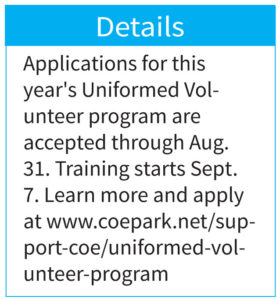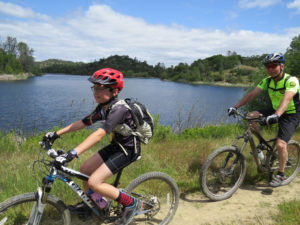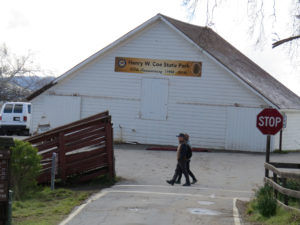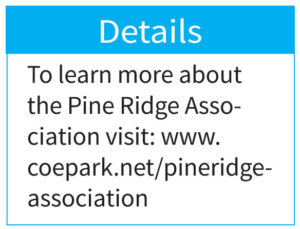Nonprofit profile: Volunteers make Henry W. Coe State Park fun for visitors
At least 50 hours of volunteer time a year is expected of participants

Dr. Anne Sanquini, right, discusses geology during a recent hike through the park.
Photo courtesy Pine Ridge Association
 By Marty Cheek
By Marty Cheek
Without the dedication of hundreds of volunteers, Henry W. Coe State Park would not be kept open. People who love nature and might wish to become a Coe “Uniformed Volunteer” have until the end of August to apply for this year’s training program.
“Henry W. Coe State Park is our wilderness next door. At over 87,000 acres, there is much to see, and much to do,” said Anne Sanquini, a geologist and uniformed volunteer who went through the 2018 class. “Each fall, the park rangers plus a cadre of experienced Uniformed Volunteers host a fun, comprehensive training program for our new volunteers. “
Online applications for this year’s program will be accepted until Aug. 31. Recruits must go through three basic training classes from 8:30 a.m. to 4:30 p.m. on three Saturdays: Sept. 7, Sept. 14, and Sept. 28. Also required is a “ride along” weekend scheduled for Oct. 12-13. Other required training takes place Oct. 26 and Nov. 9, as well as a day of the volunteer’s choosing at the Visitors Center.
Run by the nonprofit Pine Ridge Association, an organization dedicated to Coe’s preservation, the program and training is free to join. A minimum of 50 hours of volunteer time a year is expected of participants.
 Sanquini loves wilderness parks, and especially Coe, the second largest state park in California. Volunteering lets her share her interest and expertise in geology and other subjects of nature. The Uniformed Volunteers help keep Coe Park beautiful and available to all visitors throughout the year, she said.
Sanquini loves wilderness parks, and especially Coe, the second largest state park in California. Volunteering lets her share her interest and expertise in geology and other subjects of nature. The Uniformed Volunteers help keep Coe Park beautiful and available to all visitors throughout the year, she said.
“We depend on volunteers to assist staff in countless ways,” she said. “One significant contribution is to enhance visitors’ experiences through interpretation. Volunteers design and lead themed events for visitors such as Ranch Day, Tarantula Fest, the 5K/10K Run, and Backcountry Weekend. Guided hikes introduce visitors to wildflowers, songbirds, towering pines, mighty oaks, fun fungi, and exceptional geology.”
Volunteers also help protect natural resources, through removal of exotic species, monitoring and maintenance of springs, and building and maintenance of trails, she said. There are other opportunities for people interested in horse “mounted assistance” volunteering, mountain bike patrol, spring maintenance, foot patrol, and maintaining the historic Yamamoto Hot Springs former resort at the end of Roop Road east of Gilroy.
 There are volunteering opportunities for all abilities. If an individual might not wish, or be physically able, to go into the wilderness to fix trails or maintain springs, they can spend time inside the Coe Ranch Visitors Center located about 10 miles east of Morgan Hill at the end of East Dunne Avenue. Duties here include raising the flag, recording weather data, noting campground reservations and open slots, and stocking maps, drinks, and snacks for visitors. Throughout the day, volunteers sell park use passes, keep the center tidy, and help visitors plan their adventures.
There are volunteering opportunities for all abilities. If an individual might not wish, or be physically able, to go into the wilderness to fix trails or maintain springs, they can spend time inside the Coe Ranch Visitors Center located about 10 miles east of Morgan Hill at the end of East Dunne Avenue. Duties here include raising the flag, recording weather data, noting campground reservations and open slots, and stocking maps, drinks, and snacks for visitors. Throughout the day, volunteers sell park use passes, keep the center tidy, and help visitors plan their adventures.
A uniformed volunteer since he joined the program in 2011, Mike Hundt is active in encouraging people to visit Coe.
He’s often seen at events such as The Taste of Morgan Hill and the Morgan Hill Mushroom Mardi Gras, standing in a booth to provide families and individuals with information on what activities are available in the wilderness right in their backyard.
The Uniformed Volunteer program trains people to assist the rangers in managing and maintaining the park as well as help visitors have a fun and safe experience, he said. The program is open to everyone ages 18 and older. (High school students who are mature enough can join the program with a “sponsorship” from their parents.)
 The training classes include the history of the park as well as learning about the natural science of the Coe including animals, geology and weather. In October, participants go on a weekend “ride along” camping trip where they join other volunteers traveling by jeeps and trucks into the heart of Coe. The experience includes seeing the grandeur of Coe at the top of Bear Mountain and exploring the magnificent Oristimba Wilderness region. The program also has “Coe-Ed” training in November where all volunteers can get extensive training in various subjects relating to Coe.
The training classes include the history of the park as well as learning about the natural science of the Coe including animals, geology and weather. In October, participants go on a weekend “ride along” camping trip where they join other volunteers traveling by jeeps and trucks into the heart of Coe. The experience includes seeing the grandeur of Coe at the top of Bear Mountain and exploring the magnificent Oristimba Wilderness region. The program also has “Coe-Ed” training in November where all volunteers can get extensive training in various subjects relating to Coe.
“In the training program, which is quite extensive compared to other programs in other organizations, we get trained by state personnel on state procedures and how to use the radios,” Hundt said. “Knowledgeable volunteers teach them about the park — geology and plants and birds and other things.”
Coe State Park needs volunteers because there are not enough staff to manage such a large wilderness area, he said. There are three or four full-time rangers and one maintenance man in the region and they are often split up among many different parks within the district. There are many days when volunteers are manning the visitors center when there are no rangers around.
The Uniformed Volunteer program is an excellent way for South Valley residents – especially those who recently moved to the region — to make new friends with people with an interest in activities in nature.
“Some of your best friends become hiking buddies or some of your hiking buddies become best friends as you go through the park, seeing the animals and discussing and talking about what they saw or what rock formation or tree,” he said.
The foot patrol, mountain biking and other activities also are great ways to get in shape, Hundt said.
A Silicon Valley engineer who is now retired, Hundt decided to volunteer in 2010 when politicians in Sacramento were discussing closing the park to help cut costs in the state budget. He fell in love with the natural beauty of the park and decided becoming a volunteer might help keep it open. He also had a “selfish” reason, he said with a grin.
“I really wanted to get to the back country and go into the Oristimba and see what’s that’s like,” he said.
